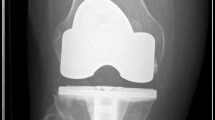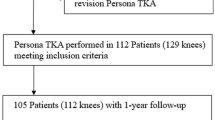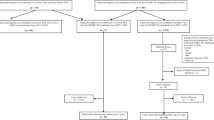Abstract
We evaluated the average 7-year survivorship and clinical results of a newer primary posterior stabilized total knee arthroplasty (TKA). The modifications in this design included a deeper patellar sulcus aimed at reducing contact stresses, improving patellar tracking, and achieving greater maximum flexion. A consecutive group of 137 patients (171 knees) who underwent TKAs using the Optetrak PS knee prosthesis between October 1997 and March 2004 were followed for an average of 6.8 years (range 4.0–11.5 years). Preoperative range of motion (ROM) and Knee Society scores were obtained and compared to that of the patients’ most recent follow-up. Manipulation under anesthesia (MUA) and revision of the implant for any reason were considered endpoints for Kaplan–Meier survival analysis of all knees. Twenty-one knees (12.3%) underwent MUA. Three knees (1.8%) underwent revision, resulting in a 97.2% survival at a mean 10 years follow-up. Pain scores and ROM significantly improved after surgery (from preoperative average of 5.3 and 105° respectively to 44.6 and 120° postoperatively). These findings suggest that this posterior stabilized knee design is both a safe and effective option for patients undergoing primary TKA.





Similar content being viewed by others
References
Aglietti P, Buzzi R. Posteriorly stabilized total-condylar knee replacement. J Bone Joint Surg (B). 1988; 70: 211–216
Bartel DL, Rawlinson JJ, Burnstein AH, et al. Stresses in polyethylene components of contemporary total knee replacements. Clin Orthop. 1995; 317: 76
Callaghan J, O’Rourke M, Goetz D, et al. Tibial post impingement in posterior stabilized total knee arthroplasty. Clin Orthop. 2002; 404: 83
Indelli P, Aglietti P, Buzzi R, Baldini A. The Insall–Burstein II prosthesis: A 5- to 9-year follow-up study in osteoarthritic knees. J Arthroplasty. 2002; 17: 544–549
Insall J, Lachiewicz P, Burstein A. The posterior stabilized condylar prosthesis: A modification of the total condylar design. J Bone Joint Surg (Am). 1982; 64: 1317–1323
Katz MM, Hungerford DS, Krackow KA, Lennox DW. Results of total knee arthroplasty after failed proximal tibial osteotomy for osteoarthritis. J Bone Joint Surg Am 1987;69:225–33.
Larson C, Lachiewicz P. Patellofemoral complications with the Insall–Burstein II posterior-stabilized total knee arthroplasty. J Arthroplasty. 1999; 14: 288–292
Puloski S, McCalden R, MacDonald S, et al. Tibial post wear in posterior stabilized total knee arthroplasty: An unrecognized source of polyethylene debris. J Bone Joint Surg (Am). 2001; 83: 390
Ritter M, Berend M, Meding J, et al. Long-term followup of anatomic graduated components posterior cruciate-retaining total knee replacement. Clin Orthop. 2001; 388: 51
Robinson R. Five-year follow-up of primary Optetrak Posterior Stabilized total knee arthroplasties in osteoarthritis. J Arthroplasty. 2005; 20: 927–931
Robinson R. The early innovators of today’s resurfacing condylar knees. J Arthroplasty. 2005; 20(Supplement): 2–26
Scott RD. Stiffness associated with total knee arthroplasty. Orthopedics. 2009; 32(9):682
Scuderi G, Clarke H. Cemented posterior stabilized total knee arthroplasty. J Arthroplasty. 2004; 19(No 4 Suppl 1):17–21
Sharkey P, Hozack W, Rothman R, et al. Why are total knee arthroplasties failing today? Section I Symposium of the Knee Society Meeting, Philadelphia, PA; 2002
Stern S, Insall J. Posterior stabilized prosthesis. J Bone Joint Surg (Am). 1992; 74: 980–986
Stiehl JB, Voorhorst PE, Keblish P, Sorrells RB. Comparison of range of motion after posterior cruciate ligament retention or sacrifice with a mobile bearing total knee arthroplasty. Am J Knee Surg 1997;10:216–20.
Author information
Authors and Affiliations
Corresponding author
Additional information
Each author certifies that he or she has no commercial associations (e.g., consultancies, stock ownership, equity interest, patent/licensing arrangements, etc.) that might pose a conflict of interest in connection with the submitted article.
Each author certifies that his or her institution has approved the reporting of this case, that all investigations were conducted in conformity with ethical principles of research.
Rights and permissions
About this article
Cite this article
Ehrhardt, J., Gadinsky, N., Lyman, S. et al. Average 7-Year Survivorship and Clinical Results of a Newer Primary Posterior Stabilized Total Knee Arthroplasty. HSS Jrnl 7, 120–124 (2011). https://doi.org/10.1007/s11420-011-9196-1
Received:
Accepted:
Published:
Issue Date:
DOI: https://doi.org/10.1007/s11420-011-9196-1




